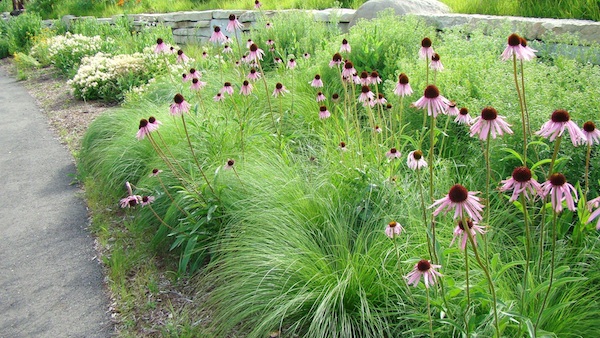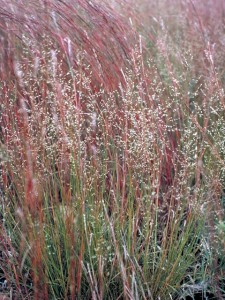
Hameln fountain grass with Russian sage in the background. Photo courtesy PerennialResource.com
A popular ornamental grass planted in thousands of Indiana landscapes was named Purdue University’s Weed of the Month in June.
Fountain grass (Pennisetum) has escaped our garden beds and spread to the lawn, say Purdue turf specialists. ‘Hameln’ and ‘Little Bunny’ are two popular cultivars.
After years of planting in the landscape, “we now realize that this species produces many viable seeds that drop onto the adjacent turf and then become tough-to-control perennial grassy weeds. Although most of the ornamental grasses cannot withstand short mowing, fountain grass does,” the professors wrote in the Weed of the Month bulletin.
Fountain grass’ ability to withstand being mowed shows up as ragged, tan blades in the lawn, making it easy to spot. Even sharp mower blades cannot make a clean cut on this plant.
Native to Africa, Asia and Australia, pennisetums are prized for their fountain form, foxtail-like plumes, multiple seasons of interest and compact size.
The annual, red fountain grass (P. setaceum ‘Rubrum’), a staple in summer containers, is not considered a problem here because neither the plant or the seed are apt to survivewinter. Howeverin warmer climates, it is an invasive weed.
The perennial fountain grass (P. alopecuroides) has spread into natural areas, called naturalizing, in New York, Pennsylvania, Illinois and Arkansas. The National Park Service’s National Capital Region Exotic Plant Management Team has issued an alert on the perennial species, identifying it “as a potential or emerging threat to natural areas in the mid-Atlantic region.”

Prairie dropseed and purple coneflower are planted together in downtown Chicago's Lurie Gardens (C) Photo courtesy Lurie Gardens
Although perennial fountain grass is not on Indiana’s invasive species list, some gardeners may want to plant alternatives if only to keep pennisetum from spreading into the lawn.
At the top of my list would be prairie dropseed (Sporobolus heterolepis). This 3 feet tall and wide native grass has a fountain form, frothy flowers and turns a beautiful golden orange/red in fall. It does not freely self sow.

Prairie dropseed flower. Photo courtesy of Wildflower.org

Prairie dropseed. Photo courtesy PerennialResource.com